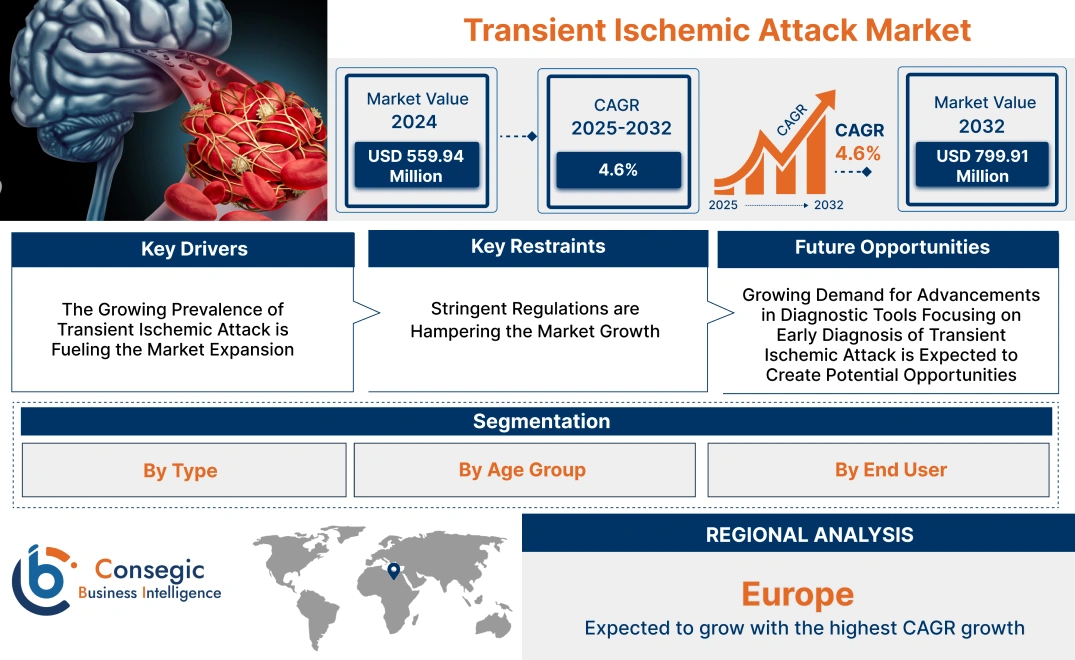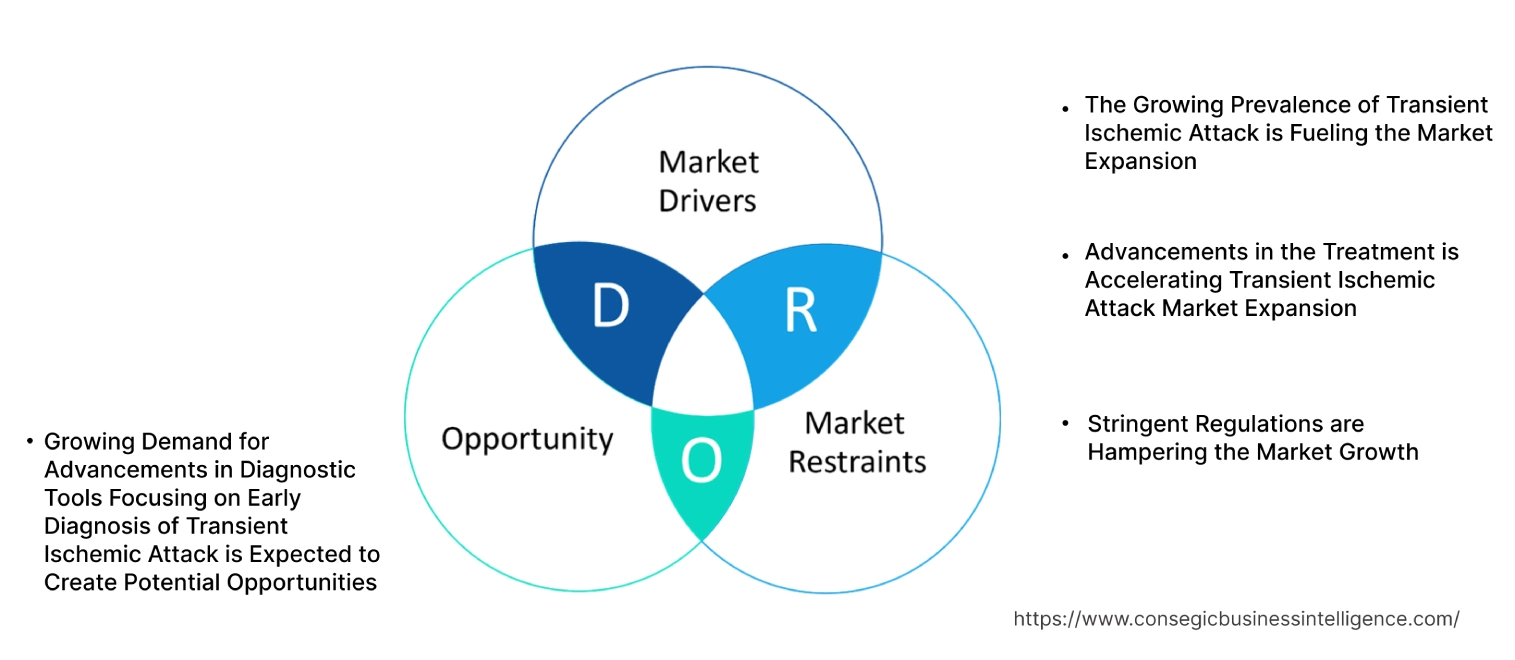Transient Ischemic Attack Market Size:
Transient Ischemic Attack Market size is estimated to reach over USD 799.91 Million by 2032 from a value of USD 559.94 Million in 2024 and is projected to grow by USD 575.49 Million in 2025, growing at a CAGR of 4.60% from 2025 to 2032.
Transient Ischemic Attack Market Scope & Overview:
A transient ischemic attack is known as a mini-stroke which is caused by the blockage of blood flow in the brain. It is defined as a transient episode of neurologic dysfunction due to a focal brain without acute infarction or tissue injury. Transient ischemic attacks are usually associated with a focal neurologic deficit and speech disturbance in a vascular territory due to underlying cerebrovascular disease. TIA usually lasts only a few minutes to an hour. The symptoms of a TIA mimic those of a stroke and appear suddenly. These symptoms include weakness, numbness, or paralysis, typically affecting one side of the body, such as the face, arm, or leg. Additionally, individuals experience slurred speech, difficulty understanding, vision problems such as blurred vision or blindness in one or both eyes, dizziness, or loss of balance and coordination.
Transient Ischemic Attack Market Dynamics - (DRO) :
Key Drivers:
The Growing Prevalence of Transient Ischemic Attack is Fueling the Market Expansion
The significant increase in the number of transient ischemic attack cases across the globe is a prominent factor in accelerating market growth. A transient ischemic attack referred to as a mini-stroke, is a brief episode of stroke-like symptoms that occurs when blood flow to the brain is temporarily blocked. The prevalence of this condition is influenced by the confluence of several factors including blood pressure or hypertension, diabetes, heart disease, atrial fibrillation, and smoking among others.
High blood pressure, or hypertension, poses the risk of damaging blood vessels, increasing the risk of blood clots. These clots block blood flow to the brain, causing this condition. Diabetes damages blood vessels and increases the risk of blood clots, making individuals with diabetes more susceptible to mini-stroke. Additionally, heart conditions such as coronary artery disease and atrial fibrillation also increase the risk of blood clots. Atrial fibrillation causes the heart's upper chambers to contract randomly. This increases the risk of clot formation and lodges in the blood vessels that supply the brain. These factors are significantly contributing to the high prevalence of transient ischemic attacks among the population.
- For instance, according to the data published by the American Stroke Association, nearly 240,000 people in the U.S. experience a transient ischemic attack every year.
This condition serves as a strong predictor of future stroke, emphasizing the critical need for timely and effective care. Healthcare providers and researchers are increasingly recognizing the importance of aggressive risk factor modification and secondary prevention strategies to minimize the risk of subsequent stroke as the risk of ischemic stroke is high after the occurrence of the condition. As a result, the market is witnessing significant growth, driven by the growing prevalence of transient ischemic attacks across the globe.
Advancements in the Treatment is Accelerating Transient Ischemic Attack Market Expansion
The growing demand for effective management solutions is creating the requirement for advancements in effective management treatment in order to prevent the risk of stroke. The development of drug-eluting stents and minimally invasive procedures for carotid artery stenosis are significantly reducing the risk of stroke in high-risk patients. Additionally, the development of novel medication formulations and combinations of medications is influencing the development of innovative medications. These advancements are leading to improved patient outcomes and a growing demand for effective therapies.
- For instance, in May 2023, the US FDA granted Milvexian developed by Bristol-Myers Squibb Company. a Fast Track Designation for use in preventing stroke after a high-risk transient ischemic attack or acute ischemic stroke. The study is randomized, double-blind, and placebo-controlled.
Moreover, the integration of artificial intelligence into healthcare has the potential to revolutionize patient care supporting further market trajectory. Hence, based on the market analysis, the advancements, including the development of innovative medical devices, medications, and the integration of artificial intelligence, are collectively contributing to improved patient outcomes and a surge in the transient ischemic attack market.
Key Restraints :
Stringent Regulations are Hampering the Market Growth
The transient ischemic attack market is subject to stringent regulations aimed at ensuring patient safety. These regulations present significant constraints for pharmaceutical and medical device companies. One major factor is the lengthy and complex drug development process. Clinical trials are rigorous and time-consuming, requiring substantial investment and resources. This, coupled with stringent regulatory hurdles, delays the approval process, hindering the timely introduction of new therapies.
Furthermore, post-market surveillance and safety monitoring requirements add to the regulatory burden. Companies must continuously monitor the safety and efficacy of their products, which becomes costly and resource-intensive, especially for smaller players. Additionally, increasing pressure on cost-effectiveness and healthcare affordability impacts the pricing and reimbursement of new treatments. Stringent pricing regulations limit profitability, discouraging further research and development efforts.
Compliance with these regulations is particularly difficult for smaller companies and startups. The rigorous regulatory environment also stifles innovation within the industry, as companies are hesitant to invest in risky or unconventional approaches due to the high cost of failure. Overall, the regulations delay product approvals, increase costs, and limit profitability, especially for smaller companies further hampering the transient ischemic attack market growth.
Future Opportunities :
Growing Demand for Advancements in Diagnostic Tools Focusing on Early Diagnosis of Transient Ischemic Attack is Expected to Create Potential Opportunities
The growing emphasis on early diagnosis of TIA is one of the prominent transient ischemic attack market opportunities. Early identification and intervention significantly reduce the risk of subsequent strokes. Diagnosing a TIA is a challenging process because symptoms are short-lived. One of the primary challenges in diagnosing transient ischemic attack is the difficulty in capturing the exact moment of symptom onset. This makes it difficult to conduct timely neurological examinations and imaging studies. Moreover, the transient nature of symptoms often leads to a delay in seeking medical attention, further complicating the diagnostic process.
- For instance, based on the analysis published in the AHA/ASA Journals , about 30% of TIAs that last less than an hour show evidence of brain injury on DWI MRI.
This creates a growing emphasis on the advancements in diagnostic tools and techniques, such as CT scans and MRIs, to enable timely and accurate diagnosis. By enabling early and accurate diagnosis, these advancements in diagnostic tools and techniques allow for prompt initiation of preventive measures and aggressive treatment strategies. This supports a significant reduction in the risk of future stroke events and improves patient outcomes. Therefore, based on the transient ischemic attack market analysis the increasing emphasis on early diagnosis trend is boosting the growth of the market.
Transient Ischemic Attack Market Segmental Analysis :
By Type:
Based on type, the market is bifurcated into diagnosis and treatment.
The treatment segment accounted for the largest market share in 2024 and is also expected to grow at the fastest CAGR over the forecast period.
- The segment is further categorized into medications, surgery, and others.
- Medication is a dosage form that contains one or more active and inactive ingredients used to improve and relieve cerebral palsy symptoms. Medications serve as the primary and first line of treatment for any disease.
- Antiplatelet medications, such as aspirin or clopidogrel, are commonly prescribed to reduce the risk of blood clots. In some cases, anticoagulant medications are recommended. Additionally, blood pressure medications help lower blood pressure and reduce the risk of future mini-attacks.
- Cholesterol-lowering medications are also prescribed to reduce the buildup of plaque in the arteries.
- Surgery is often considered for patients who have experienced a mini-stroke and have a significant narrowing of the carotid arteries, the major blood vessels in the neck that supply blood to the brain.
- The goal of surgery is to reduce the risk of a future stroke. Two common endovascular procedures for stroke prevention are thrombectomy and angioplasty with stenting.
- Thrombectomy involves the removal of a blood clot from a blood vessel, restoring blood flow to the affected area. Angioplasty, on the other hand, involves widening a narrowed blood vessel using a balloon catheter. Often, a stent is placed in the vessel to keep it open and prevent future blockages.
- Moreover, carotid endarterectomy involves surgically removing plaque buildup from the carotid arteries in the neck.
- The high incidences of transient ischemic attack are the primary factor fueling the demand for effective treatment options including medications and surgery. Moreover, the adoption of advanced technologies is positively influencing the treatment outcomes in the transient ischemic attack market.
- For instance, according to the research study published by the American Heart Association in February 2024, an artificial intelligence system utilized to help guide treatment decisions for stroke patients led to improved stroke care quality and fewer recurrent strokes, heart attacks, and vascular death among stroke survivors three months after a stroke.
- Thus, the demand for effective treatment options for transient ischemic attack is driven by its increasing prevalence and the potential for severe consequences such as stroke. Medications and surgical interventions play crucial roles in reducing the risk of future strokes and improving the quality of life for TIA patients.
By Age Group:
Based on age group, the market is categorized into below 30 years, 31 to 50 years, and above 51 years.
The above 51-year segment accounted for the largest market share of 42.77% in 2024.
- The above 51 years of age is a prominent segment as the group is particularly susceptible to the condition due to the accumulation of risk factors over time.
- The risk of developing cardiovascular conditions such as hypertension, atherosclerosis, and atrial fibrillation increases significantly in later ages.
- These underlying conditions contribute to the formation of blood clots, which block blood flow to the brain and cause transient ischemic attack.
- Additionally, age-related changes in blood vessels, such as decreased elasticity and increased stiffness, further increase the risk of this condition.
- Therefore, the prevalence of transient ischemic attacks is notably higher in older populations, making them a significant target demographic for treatment and prevention strategies.
- For instance, according to the analysis by the American Stroke Association, the risk of transient ischemic attack increases with age as stroke rates double every 10 years after the age of 55.
- Thus, considering the aforementioned trends the aging population, particularly those over 51, is a key demographic at risk for this condition.
The 31 to 50-year-old segment is expected to grow at the fastest CAGR over the forecast period.
- The 31 to 50-year age group emerges as a secondary leading group as the individuals in this category represent a growing risk profile marked by emerging health conditions, lifestyle-related risks, and developing comorbidities.
- Unhealthy lifestyle choices such as smoking, excessive alcohol consumption, and poor diet elevate the risk of ischemic strokes including TIA.
- Their treatment pattern typically focuses on early intervention and management strategies with a strong emphasis on transient ischemic attack prevention and lifestyle modification.
- Overall, the 31-50 age group is emerging as a significant demographic at risk for the condition making it a potential segment for the transient ischemic attack market trend.
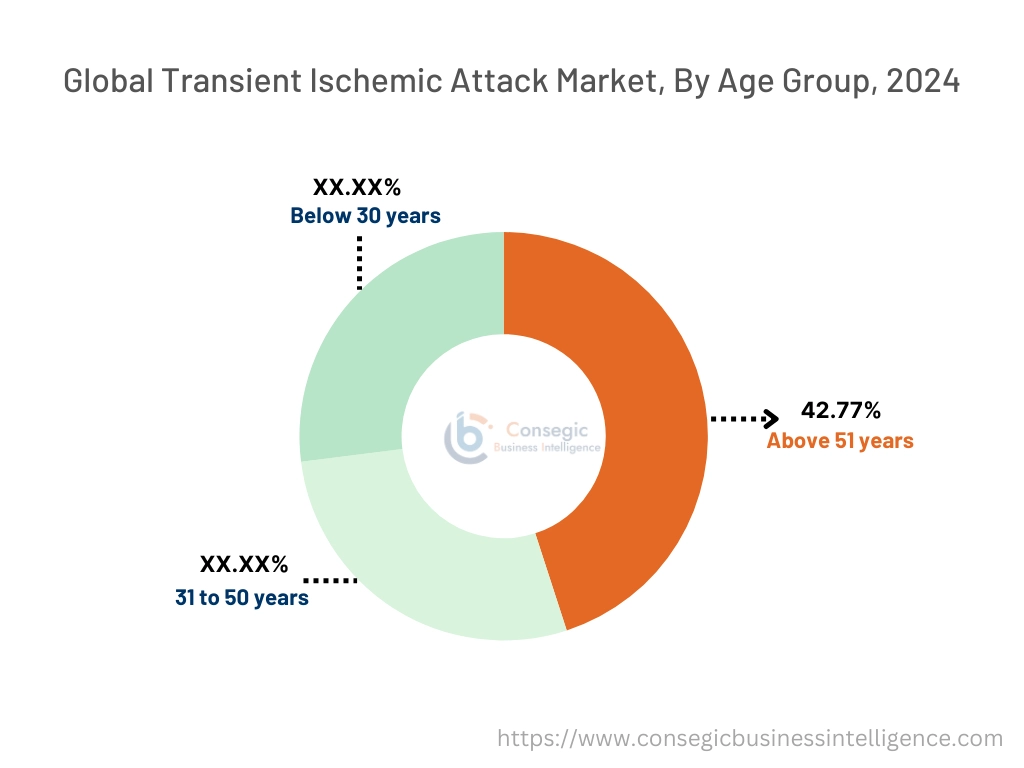
By End Use :
Based on end users, the market is categorized into hospitals, specialty clinics, ambulatory surgical centers, and others.
The hospitals segment accounted for the largest market share in the year 2024.
- Hospitals serve a crucial role as primary centers for the comprehensive treatment of transient ischemic attacks, offering a sophisticated ecosystem of medical expertise and advanced technologies.
- Modern hospital-based management monitors for early signs of this condition. They play a major and crucial role in helping patients by providing convenient, affordable, and easy access to treatment. Additionally, hospitals are equipped with state-of-the-art diagnostic techniques enabling early detection and precise diagnosis of the condition.
- Hospitals also offer the distribution of medications to their patients, which is a key factor driving the transient ischemic attack market growth across the globe.
- The inpatient treatment approach in hospitals has evolved to encompass a multidisciplinary approach making availability of various specialists in a single place. Moreover, hospitals increasingly invest in facilities equipped with specialized equipment.
- For instance, in August 2024, Stepping Hill Hospital announced the introduction of a new ‘e-patch' stroke monitor pilot scheme. The new ECG patch or e-patch will help to monitor signs of Atrial Fibrillation that increase the risk of transient ischemic attack, helping to ensure more timely and effective treatment and improved outcomes. 150 patches will be in place for patients who have been assessed by stroke clinicians as having the appropriate risk.
- Thus, owing to the aforementioned analysis hospitals serve a pivotal role in the condition diagnosis and treatment, providing comprehensive care in the transient ischemic attack market.
The ambulatory surgical center segment is expected to grow at the fastest CAGR over the forecast period.
- Ambulatory surgery centers, or ASCs, are modern healthcare facilities focused on providing same-day surgical care, including diagnostic and preventive procedures. These settings offer a convenient and cost-effective alternative to traditional hospitals for a variety of surgical procedures.
- ASCs are designed to handle procedures that do not require overnight hospitalization, allowing patients to go home on the same day. Ambulatory surgical centers are increasingly playing a role in managing patients.
- ASCs are equipped with state-of-the-art technology and experienced medical professionals to ensure the safety and efficacy of procedures.
- Many vascular procedures, such as carotid artery stenting, are performed minimally invasively in ASCs. This reduces the risk of complications and speeds up recovery.
- Additionally, ASCs often offer a more personalized and patient-centered approach to care, with shorter waiting times and more one-on-one attention.
- Overall, by offering a convenient, efficient, and cost-effective option for treating this condition, ASCs play a crucial role in reducing the risk of future strokes and improving patient outcomes in the transient ischemic attack market.
Regional Analysis:
The regional segment includes North America, Europe, Asia Pacific, the Middle East and Africa, and Latin America.
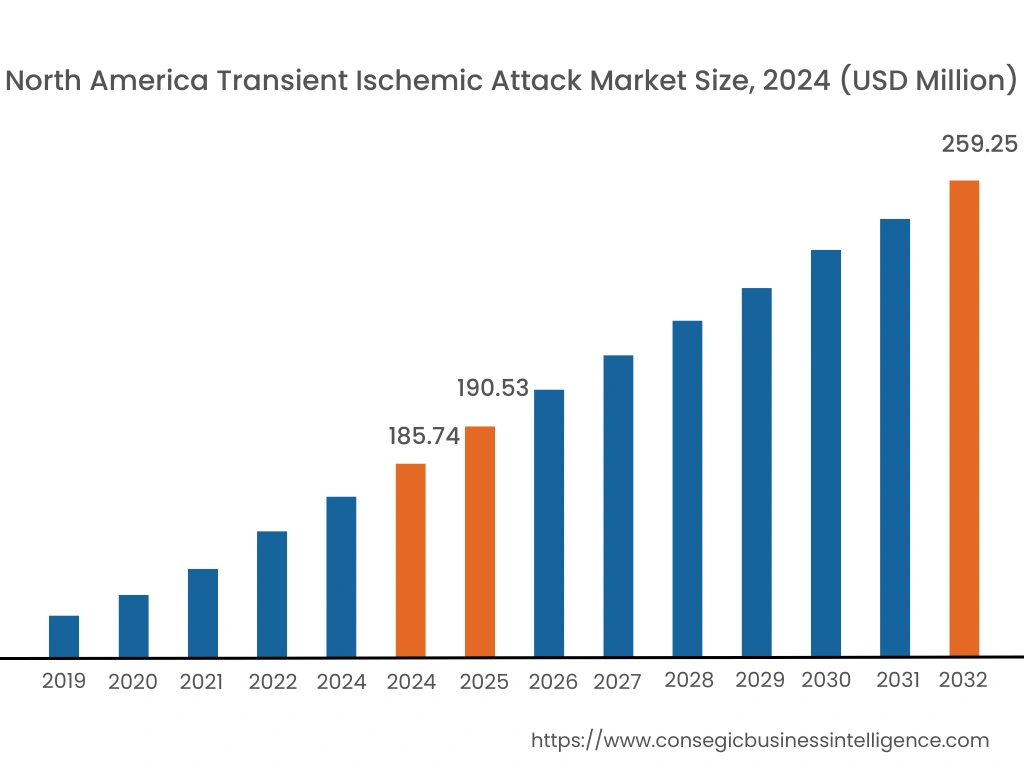
In 2024, North America accounted for the highest market share at 38.76% and was valued at USD 185.74 Million and is expected to reach USD 259.25 Million in 2032. In North America, the U.S. accounted for the highest market share of 79.88% during the base year of 2024. The transient ischemic attack market is gaining significant rise in North America owing to the confluence of multiple factors such as the region's aging population is particularly susceptible to this condition. As people age, the risk of cardiovascular diseases, including stroke and transient ischemic attack rises. The high prevalence of cardiovascular risk factors such as hypertension, diabetes, and hyperlipidemia further contributes to the increased incidence of this condition in North America.
- For instance, based on the analysis published by the Public Health Agency of Canada in January 2024, in 2020–2021, among people aged 1 year and older, 9.4% or 3.7 million were living with diagnosed diabetes in Canada.
Additionally, North America boasts a robust healthcare infrastructure with advanced diagnostic and treatment facilities, leading to timely intervention and improved patient outcomes. Moreover, growing awareness about symptoms and risk factors among healthcare providers and the general public facilitates early recognition and prompt medical attention. Furthermore, significant investments in research and development are fueling the development of novel therapies and preventive strategies for transient ischemic attacks that aim to improve patient outcomes and reduce the burden of this condition. Overall, the combination of an aging population, high prevalence of cardiovascular risk factors, advanced healthcare industry, increased awareness, technological advancements, strong healthcare insurance, and robust research efforts positions North America as a leading market for treatment and management.
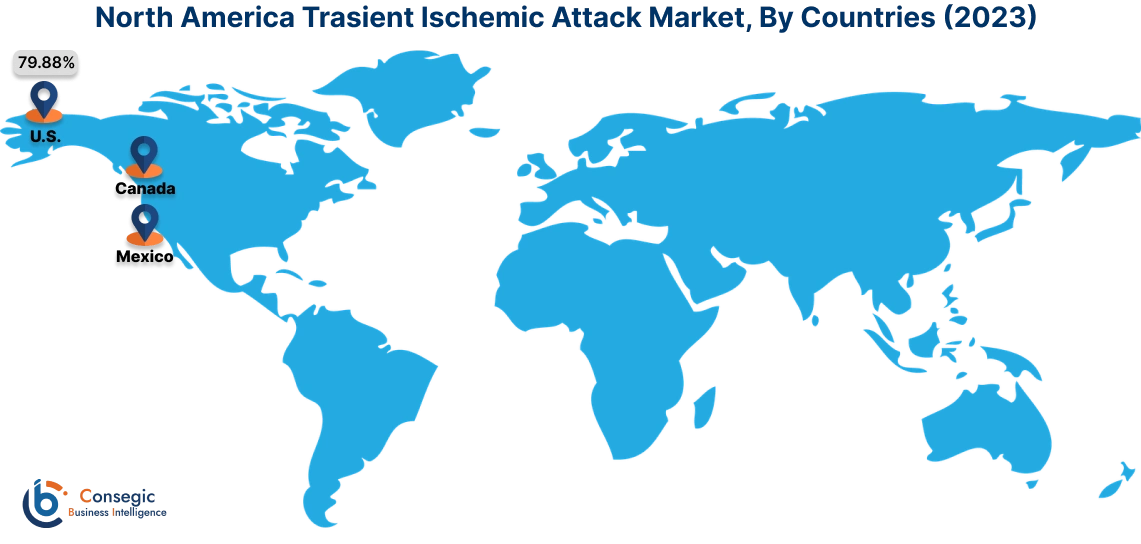
The European market for transient ischemic attack is experiencing the fastest growth with a CAGR of 5.2% over the forecast period. Europe boasts a well-developed healthcare infrastructure with advanced diagnostic and treatment facilities, enabling early detection and effective management of transient ischemic attacks. Additionally, growing awareness about symptoms and risk factors, coupled with advancements in diagnostic techniques, has led to early diagnosis and timely intervention. Many European countries have strong public healthcare systems that provide access to quality healthcare services, including those for transient ischemic attacks further propelling the market expansion.
The Asia-Pacific is experiencing steady growth for the market, attributed to factors such as the increasing prevalence of this condition, a rapidly aging population, rising healthcare expenditure, and improvements in healthcare infrastructure. As healthcare industry infrastructure develops and awareness about transient ischemic attacks increases, more cases are being diagnosed and reported. Moreover, growing healthcare investments and expanding access to pharmaceuticals in the region are further fueling transient ischemic attack market demand.
The Middle East and Africa (MEA) region is witnessing a notable surge in requirement for transient ischemic attack diagnosis and treatment solutions fuelling awareness campaigns and health education initiatives increasing knowledge about this condition and its risk factors. This leads to earlier diagnosis and timely treatment. Additionally, the burgeoning healthcare sector in the Middle East is playing a pivotal role in driving demand. Many countries in the MEA region are investing in developing their healthcare infrastructure. This includes building hospitals, and clinics, and improving access to diagnostic tools like CT scans and MRIs, which are essential for detecting TIA. The combined impact of these factors is creating a favorable environment for the trajectory of the transient ischemic attack market in the MEA region.
Latin America is an emerging region in the transient ischemic attack market. The combination of increasing prevalence, growing awareness, technological advancements, government support, and rising disposable income is driving the significant growth of the cerebral palsy market in Latin America. These factors collectively present a promising facto for healthcare providers, pharmaceutical companies, and medical device manufacturers to develop and deliver innovative solutions to address the needs of individuals with TIA in Latin America.
Top Key Players & Market Share Insights:
The Transient Ischemic Attack market is highly competitive with major players providing products to the national and international markets. Key players are adopting several strategies in research and development (R&D) and product innovation to hold a strong position in the global Transient Ischemic Attack market. Key players in the Transient Ischemic Attack industry include-
- AstraZeneca (UK)
- Pfizer (U.S.)
- Sanofi (France)
- Boehringer Ingelheim International GmbH (Germany)
- Bristol-Myers Squibb Company (U.S.)
- Johnson & Johnson (U.S.)
- Bayer AG (Germany)
- Sun Pharmaceutical Industries Limited (India)
- Novartis AG (Switzerland)
- Amgen Inc. (U.S.)
Recent Industry Developments :
Partnership:
- In July 2024, Bracco Imaging S.p.A., a player in the field of diagnostic imaging solutions, and BURL Concepts, Inc., a company that manufactures portable battery-powered ultrasound devices for non-invasive and transcranial diagnosis of strokes announced a strategic partnership that will unlock new opportunities to better diagnose and treat stroke patients.
Product Approvals:
- In November 2020, AstraZeneca announced that Brilinta (ticagrelor) has been approved in the US to reduce the risk of stroke, a leading cause of disability and death worldwide, in patients with acute ischemic stroke or high-risk transient ischemic attack.
Transient Ischemic Attack Market Report Insights :
| Report Attributes | Report Details |
| Study Timeline | 2019-2032 |
| Market Size in 2032 | USD 799.91 Million |
| CAGR (2025-2032) | 4.6% |
| By Type |
|
| By Age Group |
|
| By End User |
|
| By Region |
|
| Key Players |
|
| North America | U.S. Canada Mexico |
| Europe | U.K. Germany France Spain Italy Russia Benelux Rest of Europe |
| APAC | China South Korea Japan India Australia ASEAN Rest of Asia-Pacific |
| Middle East and Africa | GCC Turkey South Africa Rest of MEA |
| LATAM | Brazil Argentina Chile Rest of LATAM |
| Report Coverage |
|
Key Questions Answered in the Report
How big is the Transient Ischemic Attack market? +
In 2024, the Transient Ischemic Attack market is USD 559.94 Million.
Which is the fastest-growing region in the Transient Ischemic Attack market? +
Europe is the fastest-growing region in the Transient Ischemic Attack market.
What specific segmentation details are covered in the Transient Ischemic Attack market? +
Type, Age Group, and End User segmentation details are covered in the Transient Ischemic Attack market
Who are the major players in the Transient Ischemic Attack market? +
AstraZeneca (UK), Pfizer (U.S.), Johnson & Johnson (U.S.), Sanofi (France), Boehringer Ingelheim International GmbH (Germany), Bristol-Myers Squibb Company (U.S.), Bayer AG (Germany), Sun Pharmaceutical Industries Limited (India), Novartis AG (Switzerland), and Amgen Inc. (U.S.) are some of the major players in the market.
